初中英语介词讲解
初中英语介词用法总结
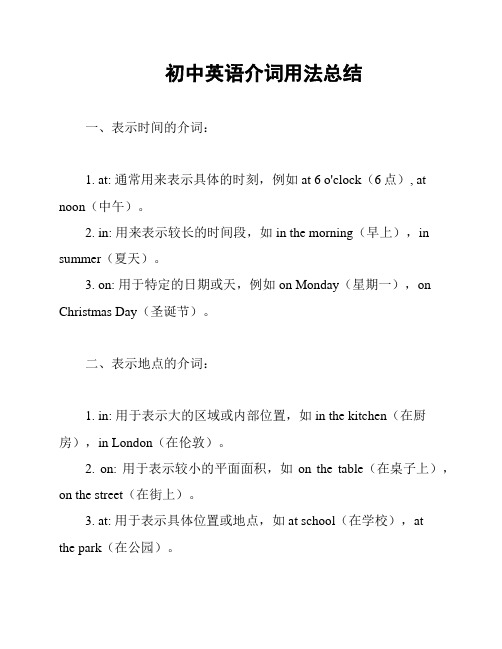
初中英语介词用法总结一、表示时间的介词:1. at: 通常用来表示具体的时刻,例如 at 6 o'clock(6点), at noon(中午)。
2. in: 用来表示较长的时间段,如 in the morning(早上),in summer(夏天)。
3. on: 用于特定的日期或天,例如 on Monday(星期一),on Christmas Day(圣诞节)。
二、表示地点的介词:1. in: 用于表示大的区域或内部位置,如 in the kitchen(在厨房),in London(在伦敦)。
2. on: 用于表示较小的平面面积,如on the table(在桌子上),on the street(在街上)。
3. at: 用于表示具体位置或地点,如 at school(在学校),atthe park(在公园)。
三、表示方式、方式、原因的介词:1. by: 表示通过某种方式或手段,如 by bus(乘公交车),by email(通过电子邮件)。
2. with: 表示伴随或使用某物,如with friends(和朋友一起),with a pen(用一支笔)。
3. for: 表示目的或原因,如 for fun(为了好玩),for the reason (因为...)。
四、表示动作方向的介词:1. to: 表示运动或行动的方向,如 go to school(去学校),send a letter to(寄一封信给)。
2. into: 表示进入某个内部空间,如 jump into the pool(跳进游泳池)。
五、表示关系和连接的介词:1. of: 表示所有关系,如 a photo of my family(我家的照片)。
2. with: 表示随同或具有某种关系,如 a girl with long hair(一位长发的女孩)。
3. to: 表示某种连接或关联,如 the key to the door(开门的钥匙)。
初中英语语法介词
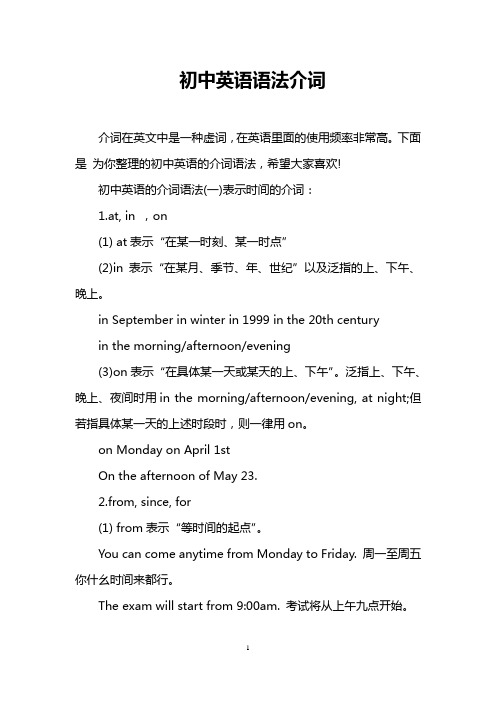
初中英语语法介词介词在英文中是一种虚词,在英语里面的使用频率非常高。
下面是为你整理的初中英语的介词语法,希望大家喜欢!初中英语的介词语法(一)表示时间的介词:1.at, in ,on(1) at表示“在某一时刻、某一时点”(2)in表示“在某月、季节、年、世纪”以及泛指的上、下午、晚上。
in September in winter in 1999 in the 20th centuryin the morning/afternoon/evening(3)on表示“在具体某一天或某天的上、下午”。
泛指上、下午、晚上、夜间时用in the morning/afternoon/evening, at night;但若指具体某一天的上述时段时,则一律用on。
on Monday on April 1stOn the afternoon of May 23.2.from, since, for(1) from表示“等时间的起点”。
You can come anytime from Monday to Friday. 周一至周五你什幺时间来都行。
The exam will start from 9:00am. 考试将从上午九点开始。
(2) since表示“自从……以来(直到现在)”He has been away from home since 1973. 他自从1973年就离开了家乡。
We have known each other since ten years ago.我们十年前就认识了。
(3) for 与since表示一段时间,但for与时间段连用,而since 与时间点连用。
for two hours since last week3.after, in, within(1) after表示“在……之后”,是before的反义词。
初中英语介词的知识点总结
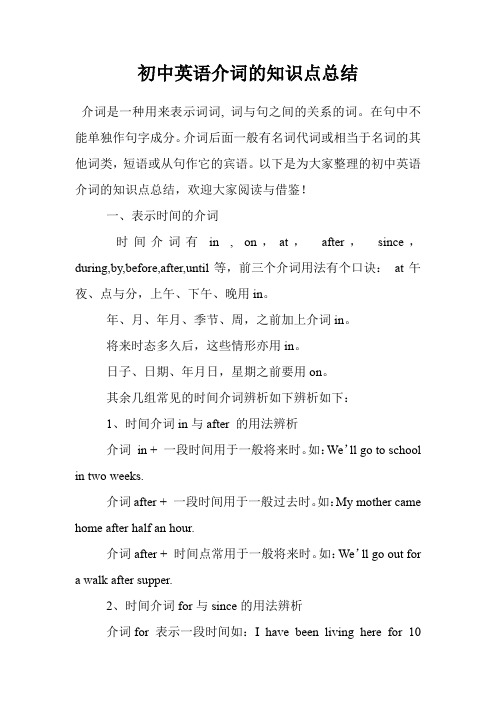
初中英语介词的知识点总结介词是一种用来表示词词, 词与句之间的关系的词。
在句中不能单独作句字成分。
介词后面一般有名词代词或相当于名词的其他词类,短语或从句作它的宾语。
以下是为大家整理的初中英语介词的知识点总结,欢迎大家阅读与借鉴!一、表示时间的介词时间介词有in , on,at,after,since,during,by,before,after,until等,前三个介词用法有个口诀:at午夜、点与分,上午、下午、晚用in。
年、月、年月、季节、周,之前加上介词in。
将来时态多久后,这些情形亦用in。
日子、日期、年月日,星期之前要用on。
其余几组常见的时间介词辨析如下辨析如下:1、时间介词in与after 的用法辨析介词in + 一段时间用于一般将来时。
如:We’ll go to school in two weeks.介词after + 一段时间用于一般过去时。
如:My mother came home after half an hour.介词after + 时间点常用于一般将来时。
如:We’ll go out fora walk after supper.2、时间介词for与since的用法辨析介词for 表示一段时间如:I have been living here for 10years.介词since 表示从过去某一时间以来如:I have been living here since 2000.3、时间介词before与by的用法辨析介词before表示“在…之前”如:He won’t come back before five .介词by表示“到…时为止,不迟于…”如:The work must be finished by Friday.4、时间介词during与for的用法辨析当所指的时间起止分明时用介词during如:He swims every day during the summer.如果一段时间不明确则用介词for如:I haven’t seen her for years.5、时间介词till与until用法的异同till和until用在肯定句中,均可表示“直到…为止”,如:I will wait till(until)seven o'clock.till和until用在否定句中,均可表示“在…以前”或“直到…才”。
初中英语中的常见介词解析

初中英语中的常见介词解析介词是英语中一个非常重要的词类,它用来连接名词、代词、动词等词语,并且在句子中起到标示关系的作用。
初中英语中有许多常见的介词,它们的用法和意义对于初学者来说可能会有些困惑。
本文将对初中英语中常见的介词进行解析,帮助读者更好地理解和运用这些介词。
1. in介词"in"可以表示位置、时间、状态等。
在表示位置时,它可以表示某物在某个地点内部,比如:"There is a book in the bag."(书包里有一本书);"The cat is in the box."(猫在盒子里)。
在表示时间时,它可以表示某事发生的时间点,比如:"I will arrive in ten minutes."(我将在十分钟内到达);"We usually have dinner in the evening."(我们通常在晚上吃晚饭)。
在表示状态时,例如:"I am interested in music."(我对音乐感兴趣)。
2. on介词"on"用于表示位置、时间、方式等。
在表示位置的时候,它通常表示某事物或某人在某物体的表面上,比如:"Put the book on the table."(把书放在桌子上);"The cat is sitting on the chair."(猫坐在椅子上)。
在表示时间的时候,它可以表示某事发生的具体日期或某个时间点,比如:"My birthday is on June 1st."(我的生日是在6月1日);"She will arrive on time."(她将准时到达)。
在表示方式的时候,例如:"I learned English on my own."(我自学英语)。
初中英语语法专题—介词讲解
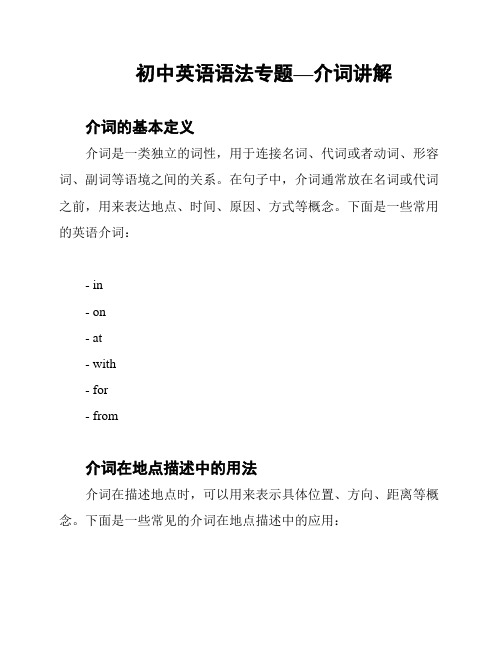
初中英语语法专题—介词讲解介词的基本定义介词是一类独立的词性,用于连接名词、代词或者动词、形容词、副词等语境之间的关系。
在句子中,介词通常放在名词或代词之前,用来表达地点、时间、原因、方式等概念。
下面是一些常用的英语介词:- in- on- at- with- for- from介词在地点描述中的用法介词在描述地点时,可以用来表示具体位置、方向、距离等概念。
下面是一些常见的介词在地点描述中的应用:- in:用于表示在某个范围之内的位置,例如 "in the room"(在房间里),"in the park"(在公园里)。
- on:用于表示在表面、平台或者位置上的状态,例如 "on the table"(在桌子上),"on the bus"(在公交车上)。
- at:用于表示在某个具体位置或者地点,例如 "at the cinema"(在电影院),"at school"(在学校)。
- to:用于表示朝向某个位置的移动,例如 "go to the park"(去公园)。
介词在时间描述中的用法介词在描述时间时,可以用来表示具体时间、时间段等概念。
下面是一些常见的介词在时间描述中的应用:- at:用于表示具体的时间点,例如 "at 7 o'clock"(在7点钟)。
- on:用于表示具体的日期或者星期几,例如 "on Monday"(星期一),"on January 1st"(1月1日)。
- in:用于表示较长的时间段或者某一个时间段内,例如 "inthe morning"(早上),"in July"(在七月)。
介词在原因描述中的用法介词在描述原因时,可以用来表示某事的起因或者原因。
初中英语语法之介词

初中英语语法之介词初中英语语法大全之介词介词(preposition 简写prep.)又称作前置词,表示名词、代词等与句中其他词的关系,在句中不能单独作句子成分。
下面是店铺精心为大家整理的关于介词的初中英语语法知识,希望对大家有帮助!初中英语语法之介词篇1I介词的功能介词是一种虚词,用来表示名词或相当于名词的其它词语句中其它词的关系,不能单独使用。
介词可与名词或相当于名词的其它词构成介词短语。
介词短语可在句中作定语,状语,表语和宾语补足语。
例如:The boy over there is John’s brother. (定语)The girl will be back in two hours. (状语)Our English teacher is from Australia. (表语)Help yourself to some fish. (宾语补足语)II表示时间的介词表示“时间”的介词如下:1.表示年、月、日、时刻等用at,in,on2.表示时间的前后用 before, after3.表示期限等用by,until,till4.表示期间等用for,during,through5.表示时间的起点等用 from, since6.表示时间的经过等用in,within(1) at,on,in1)at:用于表示时刻、时间的某一点at noon正午时 at night在夜间 at present目前at nine(o’clock)在九点钟We usually have lunch at noon(at twelve).我们通常中午吃午饭(十二点吃午饭)。
(2)on:用于某天,某一天的上、下午(指具体的某一天时,一律用on)注意 :泛指一般的上午(下午)时用in,但特指某日的上午(下午)时用on。
in the morning在早上on sun day morning在周日早上on Monday在周一on Tuesday morning在周二早上on June 6在6月6日on May 4,1996在1996年5月4日on a cold night在一个寒冷的夜晚on the night of July(the) first在七月一日的夜晚We didn't listen to the lecture on Wednesday afternoon上周三下午我们没去听演讲。
【教育资料】初中英语 介词讲解学习精品

介词一、概述介词一般置于名词之前,它常和名词或名词性词语构成介词短语。
同一个介词常和不同的词语搭配形成固定搭配,表示不同意义。
根据介词本身的意义,可将介词分为时间介词、方位介词、动向介词、方式介词、原因介词等(见下表)。
二、常用介词的基本用法at1)表示具体的时间点:I go to school at seven every day 我每天早上7点去上学。
2)表示一段较短的时间:at night 在夜晚at Christmas 在圣诞节3)表示在某一具体地点:He is standing at the bus stop 他站在公共汽车站。
4)表示动作的方向、目标:Let me have a look at the picture 让我看看这幅图。
5)表示人的年龄:at the age of six 在六岁6)用于某些固定搭配:at once 立刻、马上at last 最后at the same time 同时at first 开始时not at all 一点也不about1)表示大约时间:It’s about six o’clock now. 现在大约6点钟了。
2)表示地点;在……周围:She is somewhere about the office. 她在办公室附近。
3)关于,对于:We are talking about the news. 我们正在谈论新闻。
after1)在……之后:After dinner I watch TV. 晚饭后我看电视。
2)在……后面:He came into the room after me. 他在我后面进了房间。
3)after+某个时间,表示从过去某个时间起过多长时间,多用于过去时,如:She left on Sunday and returned after three days.behind1)在……之后:There is a bike behind the tree. 树后有一辆自行车2)比……晚,迟于:The train is behind time. 火车晚点了by1)在……旁:He is sitting by the bed. 他正坐在床边。
初中英语知识点归纳介词的用法
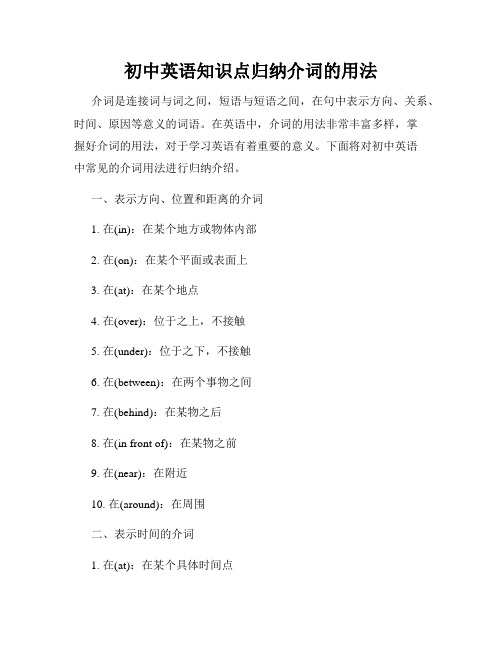
初中英语知识点归纳介词的用法介词是连接词与词之间,短语与短语之间,在句中表示方向、关系、时间、原因等意义的词语。
在英语中,介词的用法非常丰富多样,掌握好介词的用法,对于学习英语有着重要的意义。
下面将对初中英语中常见的介词用法进行归纳介绍。
一、表示方向、位置和距离的介词1. 在(in):在某个地方或物体内部2. 在(on):在某个平面或表面上3. 在(at):在某个地点4. 在(over):位于之上,不接触5. 在(under):位于之下,不接触6. 在(between):在两个事物之间7. 在(behind):在某物之后8. 在(in front of):在某物之前9. 在(near):在附近10. 在(around):在周围二、表示时间的介词1. 在(at):在某个具体时间点2. 在(in):在某个时间段3. 在(on):在某个具体日期三、表示原因的介词1. 因为(of):表示原因、缘故2. 由于(because of):表示原因、由于四、表示目的、用途和方式的介词1. 为了(in order to):表示目的2. 以便(in order that):表示目的3. 用(with):表示使用的手段或工具4. 通过(by):表示方式、方法5. 以(for):表示目的五、表示比较的介词1. 比较起见(than):表示比较的对象2. 和(with):与某人或某物在一起六、其它常见的介词1. 关于(about):表示涉及某一话题2. 靠(by):表示接近某人或某物3. 经过(through):表示通过某地或某事4. 编写(at):表示在某地工作或活动5. 因(as):表示角色、身份6. 例如(for example):表示举例7. 包括(including):表示包含某物以上是初中英语中常见的介词用法的归纳总结。
熟练掌握这些介词的用法,对于构建正确的句子和语法结构非常重要。
希望能对你的学习有所帮助。
初中英语语法全解——介词(共21张PPT)

6.across, through, past, over, along, down across表示从物体表面横穿;through表示穿过 空间;past表示从某物的一旁经过;over表示从 一边到另一边;along/down表示“沿着”。 John is going to swim across the river tomorrow. She smiled at him as he walked through the door. Walk down the road.
9.as as可以表示“像、按照”,也可以表示“作为”。 You ought to do as the teacher tells you. 10.against against表示“反对”。 There are 10 votes for him and only 2 against him.
Hale Waihona Puke 5.like like表示“像”。 Her hair is dark brown like mine. 6.with with可以表示“和......一起”,也可以表示“带 有”,还可以表示行为方式等。 She came back with a letter in her hand.
7.without without表示“没有,无”。 He found the place without difficulty. 8.for for可以表示目的,也可以表示原因。 I look after the kids for them.
5.before, after ①before后接时间点,表示“在某个时间之前”。 Must I finish my homework before supper? ②after后节时间点,表示“在某个时间之后”。 I go swimming every day after work.
初中英语介词用法总结
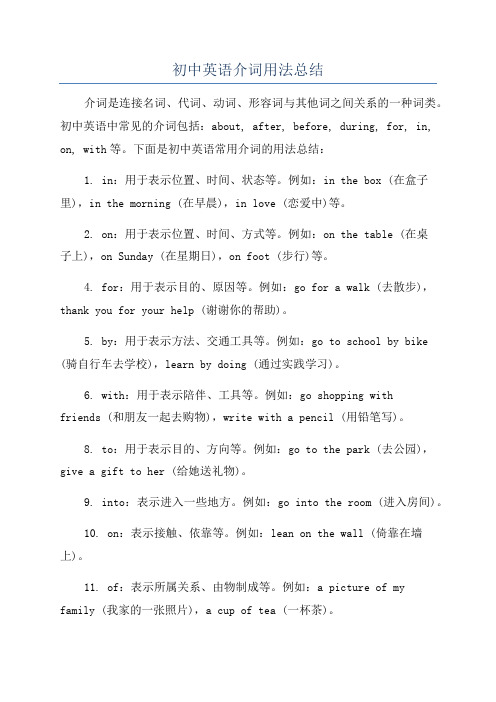
初中英语介词用法总结介词是连接名词、代词、动词、形容词与其他词之间关系的一种词类。
初中英语中常见的介词包括:about, after, before, during, for, in, on, with等。
下面是初中英语常用介词的用法总结:1. in:用于表示位置、时间、状态等。
例如:in the box (在盒子里),in the morning (在早晨),in love (恋爱中)等。
2. on:用于表示位置、时间、方式等。
例如:on the table (在桌子上),on Sunday (在星期日),on foot (步行)等。
4. for:用于表示目的、原因等。
例如:go for a walk (去散步),thank you for your help (谢谢你的帮助)。
5. by:用于表示方法、交通工具等。
例如:go to school by bike (骑自行车去学校),learn by doing (通过实践学习)。
6. with:用于表示陪伴、工具等。
例如:go shopping withfriends (和朋友一起去购物),write with a pencil (用铅笔写)。
8. to:用于表示目的、方向等。
例如:go to the park (去公园),give a gift to her (给她送礼物)。
9. into:表示进入一些地方。
例如:go into the room (进入房间)。
10. on:表示接触、依靠等。
例如:lean on the wall (倚靠在墙上)。
11. of:表示所属关系、由物制成等。
例如:a picture of myfamily (我家的一张照片),a cup of tea (一杯茶)。
12. with:表示伴随、具有。
例如:a girl with long hair (一个长发的女孩),a book with pictures (一本有图片的书)。
介词的用法(初中英语)
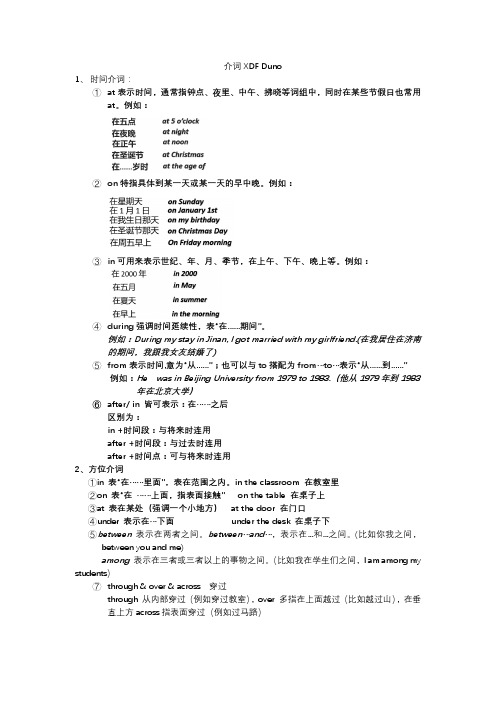
介词XDF Duno1、时间介词:①at表示时间,通常指钟点、夜里、中午、拂晓等词组中,同时在某些节假日也常用at。
例如:②on特指具体到某一天或某一天的早中晚。
例如:③in可用来表示世纪、年、月、季节,在上午、下午、晚上等。
例如:④during强调时间延续性,表“在......期间”。
例如:During my stay in Jinan, I got married with my girlfriend.(在我居住在济南的期间,我跟我女友结婚了)⑤from表示时间,意为“从......”;也可以与to搭配为from…to…表示“从......到......”例如:He was in Beijing University from 1979 to 1983.(他从1979年到1983 年在北京大学)⑥after/ in 皆可表示:在……之后区别为:in +时间段:与将来时连用after +时间段:与过去时连用after +时间点:可与将来时连用2、方位介词①in 表“在……里面”,表在范围之内。
in the classroom 在教室里②on 表“在……上面,指表面接触”on the table 在桌子上③at 表在某处(强调一个小地方)at the door 在门口④under 表示在…下面under the desk 在桌子下⑤between 表示在两者之间。
between…and…,表示在...和...之间。
(比如你我之间,between you and me)among 表示在三者或三者以上的事物之间。
(比如我在学生们之间,I am among my students)⑦through & over & across 穿过through 从内部穿过(例如穿过教室),over 多指在上面越过(比如越过山),在垂直上方across指表面穿过(例如过马路)2、方式介词①with “用”表示使用工具:with my phone表示使用某种器官:see with our eyes(用我们眼睛看)②in “用”表示使用某种语言:in English 用英语表示使用声音:in a high voice 使用高声表示穿某种颜色衣服:in white 穿白颜色的衣服③by表示乘坐交通工具后面直接加交通工具即可by bus乘公交。
(完整版)初中英语语法介词用法讲解与练习

(完整版)初中英语语法介词用法讲解与练习介词1.表示时间的介词:at, in, on, before, to, from, by, till, until, after, for, since 等。
2.表示地点,位置,方向的介词:next, to, in, in front of, on , out of, at, above, over, into, near, between, under, up, across, by, down, from, around, behind, beside等3.表示原因,理由的介词:for, as, at, from 等4.表示方式的介词:on, in, by, with 等。
常用介词辨析1.表示时间的in, on, at, after1)in 的用法。
用于早晨、下午、傍晚。
In the morning/afternoon/evening用于月、年、季节等。
In March, in 1986, in spring用于一段时间后。
In a week, in a year’s time, in two hours2)on 的用法用于具体某一天。
On my birthday, on the morning of next Friday, on June 6, on Sunday, on New Year’s Day用于描述性的时间。
On a cold night, on a winter day3)at 的用法用于具体的钟点。
At 12 o’clock, at half nine用于固定的搭配。
At lunch, at night, at breakfast, at noon, at Christmas, at weekends, at that time 4)after 表示在一点时间以后。
After twelve o’clock2. 表示的地点的in, on , atin指大地方,at是小地点,in表示的是体,on表示的是面,at表示的是点。
初一英语常见介词用法归纳
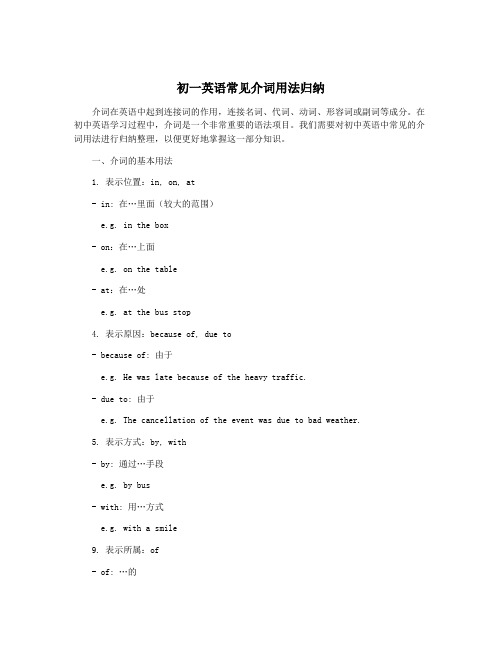
初一英语常见介词用法归纳介词在英语中起到连接词的作用,连接名词、代词、动词、形容词或副词等成分。
在初中英语学习过程中,介词是一个非常重要的语法项目。
我们需要对初中英语中常见的介词用法进行归纳整理,以便更好地掌握这一部分知识。
一、介词的基本用法1. 表示位置:in, on, at- in: 在…里面(较大的范围)e.g. in the box- on:在…上面e.g. on the table- at:在…处e.g. at the bus stop4. 表示原因:because of, due to- because of: 由于e.g. He was late because of the heavy traffic.- due to: 由于e.g. The cancellation of the event was due to bad weather.5. 表示方式:by, with- by: 通过…手段e.g. by bus- with: 用…方式e.g. with a smile9. 表示所属:of- of: …的e.g. the hat of the boy2. look forward to: 期待e.g. I am looking forward to the summer vacation.5. be interested in: 对…感兴趣e.g. Amy is interested in learning Chinese.三、常见介词错误用法及纠正1. 错误用法:depend of正确用法:depend one.g. We depend on each other.通过以上的介词错误用法及纠正,我们可以更清晰地了解该如何正确使用这些介词。
四、综合练习通过上述的综合练习,可以帮助大家更好地掌握介词用法。
初中英语介词知识点归纳

初中英语介词知识点归纳介词是英语中非常重要的一部分,它用来建立词与词、句与句之间的关系,能够使句子结构更加完整且信息更加准确。
在初中英语学习中,了解和掌握介词的用法和常见的搭配是非常重要的。
下面就来归纳一些初中英语中常见的介词知识点。
1. 表示地点的介词常见的表示地点的介词有:at, in, on, under, above, below, near, beside等。
例如:- I live in a big city.- The book is on the table.- The cat is under the chair.- The bird is flying above the tree.- She is standing beside her friend.2. 表示时间的介词常见的表示时间的介词有:at, in, on, before, after, during, for等。
例如:- I go to school at 7 o'clock.- We have a holiday in summer.- She always listens to music before going to bed.- They play soccer after school.- We studied for two hours.3. 表示原因的介词常见的表示原因的介词有:because of, due to, thanks to等。
例如:- He couldn't come because of the bad weather.- The match was canceled due to the heavy rain.- Thanks to your help, I finished my homework.4. 表示目的的介词常见的表示目的的介词有:for, to等。
例如:- He bought a gift for his mother.- She went to the supermarket to buy some food.5. 表示方式的介词常见的表示方式的介词有:by, with等。
英语介词用法详解(初中)

英语介词用法详解(初中)介词是一种虚词,不能独立充当句子成分,需与动词、形容词和名词搭配,才能在句子中充当成分。
介词是用于名词或代词之前,表示词与词之间关系的词类,介词常与动词、形容词和名词搭配表示不同意义。
介词短语中介词后接名词、代词或可以替代名词的词(如:动名词v-ing).介词后的代词永远为宾格形式。
一、表示时间的介词(一)表示时间段的介词(1)in , afterin +时间段,表示从现在起往后推算一段时间after +时间段,表示过去某时间往后推算一段时间,如:He’ll come back in two days. 但点钟用after( after three o’clock)He left on July 2 and returned after three days.(2)in , during表示在一段特指的时间内,可用in 或duringThe work was done in / during the holidays.表示年份、月份、季节用in , 如:in 1999 ,in June , in winter(3)in last, for the past + 时间段, during表示在最近一段时间内,句中谓语动词常用现在完成时I have been in Shanghai in the last few years.(4)for 表示延续一段时间。
I’ll study in the U.S for two yearsI’ve waited for Bingo for half an hour.(二)表示某一时间的介词(1)at, onat 表示某一时刻,on 表示某一天或日期, 如:at 7:14, on Saturday morning on the night of May2一天内各段时间表达, 选用正确的介词,请比较:in the morningon a winter / snow / cold / morningat nighton the night of March 7thin the eveningon Friday evening(2)before, bybefore 表示某一时间之前,而by 表示到某一时间止,句中谓语动词多用完成时态。
初中英语介词讲解

@WPS官方微博 @kingsoftwps
•on: 接壤;相邻 •to: 表示“相离;相隔”,两者不属同一范围,也 不接壤。 •behind: 在...后面 •beside:在关系时 •in:同一范围内 •in the east of China 中国南方 •to:不同范围内,也不接壤 •Japan is to the east of China •日本在中国的东面 •on:接壤;相邻 •Anhui is on the east of Fujian
五、表示运动方向的介词
across意为“从……表面穿过”;横穿 through意为 “从……内部穿过”;直穿 past和by表示“从旁边经过或路过”。如: Please be careful when you go ________ the street. Look! The mosquito is trying to fly ________ th window. We often go ________ a bakery on our way to school.
安徽在福建的东面/安徽在福建的东部于其接壤。
四、表示方式的介词
• 1. by + 交通工具,意为“乘坐……”。 • 海:by ship / boat / sea • 陆:by bus / car / train / bike / taxi • 空:by air / plane / spaceship • 2. on foot为固定短语,意为“步行”。
• 用in, by, on填空。 • 1. They often go to school _______ foot. • 2. Does he usually go home _______ bike? • 3. She went to Qingdao _______ ship last • week. • 4. I want to go to Beijing _______ bus. • 5. She often comes to school _______ her • father’s car. • 6. Did you come here _______ a taxi?
初中英语语法复习之介词讲解-(共50张PPT)
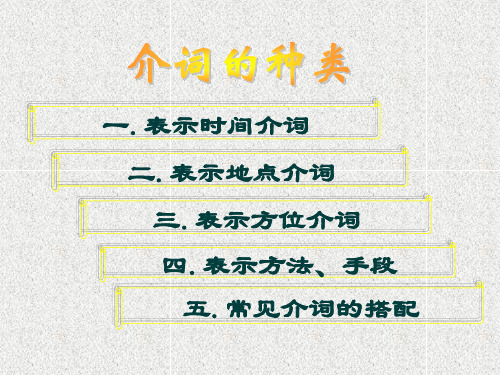
8.in a read coat, the girl in yellow, the boy in white…
3. in English , in French , in your own words, in three language… ____使_用_语__言_用__介_词__in_______
4. in a loud voice, in a low voice… ___使__用_声_音__用_介_词__i_n_____
A. on, over B.above, on C.over, on 5.The sun rose ___the horizon(地平线).
A. on B. above C.over 注意: on 接触平面
over 在平面的正上方 above 在上方
3. in + 大地方 at + 小地 方 on +门牌,某层楼
in space…
____表__示__大__地__方__用__i_n______
❖ 3. in the box, on the chair, under the desk, next to Kate, on the right of Lucy, in front of the house, behind the door…
介词:通常用在____代_词____、___名_词___、__动_名__词__
之前,表示某个人、事物/东西、事件与 另一个之间的___关__系____。
初中英语语法—介词(26张)PPT课件
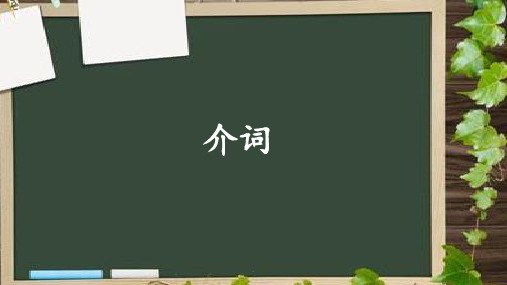
-
1
介词的分类方时 地式间 点介介 介词词 词
介词介词短语b动介e+词词形++容介名词词词+介词
介词的功能定 表语 语
状语 宾语
-
2
1.表时间时,at强调“点”,in强调“段”,on强调“日”和某日的早、中、晚。 I got there at eight this morning. 今天早上我八点到那。
-
5
The teacher had already started teaching by the time she got to class. 当她到班级的时候老师已经开始讲课了。 6.表地点时,in表示“范围较大的地方”,强调“空间”;at表示在“范 围较小的地方”,强调“点”。 I live in China. 我居住在中国。 We often wait for the bus at the bus stop. 我们通常在公共汽车站等车。 7.表位置时,in表示“在……内”,on表示“在……上”(接触表面), on还可以表示“在两边”“在左/右边”。
-
8
The sunshine got into the room through the glass. 阳光透过玻璃进入房间。 11.behind表示“在……的后面”,其反义词组“in front of”表示“ 在……的前面”,注意与in the front of 的区别。 We must keep our hands behind our backs. 我们必须一直把手放在背后。 I was walking down the street when a friend of mine stood in front of me. 当一个朋友站在我面前时,我正沿着街道散步。
初中英语介词归纳

初中英语介词归纳介词在英语中起着非常重要的作用,它们表示名词、代词与其他词之间的关系。
对于初中生来说,掌握介词的用法是英语学习的重要一步。
本文将对初中英语中常见的介词进行归纳和解释,帮助学生更好地理解和运用介词。
一、表示位置的介词1.at:表示一个具体的点或位置。
例如:at home(在家),at school(在学校)。
2.in:表示在一个范围或区域之内。
例如:in the city(在城市里),in the classroom(在教室里)。
3.on:表示在某个物体的表面之上。
例如:on the table(在桌子上),on the wall(在墙上)。
二、表示时间的介词1.at:用于表示具体的时间点。
例如:at seven o’clock(在七点),at noon(在中午)。
2.on:用于表示具体的某一天或某一天的上午、下午、晚上。
例如:on Monday(在周一),on the morning of July 1st(在七月一日的上午)。
3.in:用于表示一段时间,如年、月、季节等。
例如:in 2023(在2023年),in spring(在春天)。
三、表示方式的介词1.by:表示通过某种方式或手段。
例如:by bus(乘公交车),by email(通过电子邮件)。
2.with:表示使用某种工具或伴随某种情况。
例如:write with a pen(用钢笔写),with pleasure(很高兴地)。
四、其他常用介词1.about:表示关于某个话题或大约的数量。
例如:talk about(谈论),about ten books(大约十本书)。
2.after:表示在某个时间或事件之后。
例如:after school(放学后),after dinner(晚饭后)。
3.before:表示在某个时间或事件之前。
例如:before breakfast(早餐前),before class(课前)。
4.under:表示在某个物体的下方。
- 1、下载文档前请自行甄别文档内容的完整性,平台不提供额外的编辑、内容补充、找答案等附加服务。
- 2、"仅部分预览"的文档,不可在线预览部分如存在完整性等问题,可反馈申请退款(可完整预览的文档不适用该条件!)。
- 3、如文档侵犯您的权益,请联系客服反馈,我们会尽快为您处理(人工客服工作时间:9:00-18:30)。
介词介词(虚词),不能在句子中独立充当成分。
它总是用于名词、代词、或相当于名词的其它词类或短语从句前。
一.时间介词的用法辨析1. 时间介词in、on、at、by的用法辨析A. 介词in + 年、月、季节及一天中的某部分如:in the morningB. 介词 on + 具体某天(具体某天的上、下午等;星期词;以及上、下午词前有修饰词时)如:on a rainy dayC. 介词at用来表示特定的时间、节日、年龄等。
at + 具体时刻:at noonat night 的意思是during any night,通常表泛指;in the night的意思是during one particular night,通常表特指D. 介词by表示…的时候、到、等到…已经等用在天、时间的前面。
如:by 2 o‘clo ck另外注意:在时间词(morning , afternoon , evening ; Sunday…)前有last, next , this , that时,不再用介词. tomorrow, tonight前也不用介词。
2. 时间介词in与after 的用法辨析A. 介词in + 时间段一般将来时。
如:We’ll go to school in two weeks.B. 介词after + 时间段一般过去时。
如:My mother came home after half an hour.C. 介词after + 时间点一般将来时。
如:We’ll go out for a walk after supper.3. 时间介词for与since的用法辨析. 介词for 表示一段时间如:I have been living here for 10 years.介词since 表示从过去某一时间以来如:I have been living here since 2000.4. 时间介词during与for的用法辨析A. 当所指的时间起止分明时用介词during 如:He swims every day during the summer.B. 如果一段时间不明确则用介词for 如:I haven’t seen her for years.5. 时间介词before与by的用法辨析A. 介词before表示“在…之前”如:He won’t come back before five .B. 介词by表示“到…时为止,不迟于…”如:The work must be finished by Friday.6. 时间介词till与until用法的异同A. till和until用在肯定句中,均可表示“直到…为止”,如:I will wait till(until)seven o'clock.B. till和until用在否定句中,均可表示“在…以前”或“直到…才”。
如:Tom didn't come back till(until)midnight.C. till多用于普通文体,而until则用于多种文体,并且在句子开头时,用until而不用till。
如:Until he comes back,nothing can be d one.7. 不用介词表达时间的几种情况A. 当表示时间的词前有this, that时,其前面不用介词,如:this morningB. 当表示时间的词前有next时,其前面不用介词,如:next SundayC. 当表示时间的词前有last时,其前面不用介词,如:last SundayD. 当表示时间的词前有one, any, each, every, some或all时,其前面不用介词,如:You can come any day.二.方位介词与地点介词的用法辨析1. 方位介词on, over, above的用法辨析A. 介词on表示一物放在另一物上面,两者紧贴在一起,如:The book is on the tabl e.B. 介词over表示一种垂直悬空的上下关系,即“在…上方”,如:Is there any bridge over the river?C. 介词above表示一般的“高于…”,“在…之上”,如:There was an el ectric cl ock above his bed.2. in, on 表示"在……上"时,不是都用"on",有时须用in。
在树上in the tree 用于指树上的鸟、人等。
on the tree用于指生长在树上的叶子、果实。
在墙上in the wall镶嵌在墙内,指窗户、门、钉子等。
on the wall在墙的表面之上,指地图、画像等。
在报纸上in the newspaper用于指报上的内容。
on the newspaper用于指放在报纸上的东西,如眼镜等3.方位介词und er与below的用法辨析A. 介词und er是over的反义词即“在…下方”,如:They were seen und er the tree.B. 介词below是above的反义词即“低于…”,“在…之下”,如:They live below us.4. 方位介词across/cross,、through、over,、past的用法辨析A. 介词across/cross着重于“从一头或一边到另一头或另一边”,强调从表面穿过。
如:She went across the street to make some purchases.B. 介词through着重于“穿越”,强调从一定的空间内穿过。
如:The sunlight was coming in through the wind ow.C. 介词over多表示从“上方越过”,如:He fail ed to go over the mountain; he had to go round it.D. 介词past表示从“面前经过”,如:Someone has just gone past the wind ow.5. 方位介词in、on、at的用法辨析A. 介词in表示“排、行、组”,如:We are in Team One.B. 介词on表示“左、右”,如:Li Ping is on my l eft.C. 介词at表示“前、后”,如:I sit at the front of the classroom.6. 方位介词to、for的用法辨析A . 介词to表示目的地或去的目的,如:Wil you take a train to Tianjian.B. 介词for表示动身去某地,如:He got on a train for Shanghai.7. 地点介词at与in的用法辨析A. 介词at表示较小的地方,如家、村、乡村等,如:He lives at a small village.B. 介词in表示较大的地方,如大城市、国家、洲等,如:He lives in Beijing.8. 地点介词at与on的用法辨析A. 介词at用于门牌号,如:He lives at No.200, Nanjing Road.B. 介词on用于路名,如:He lives on Nanjing Road.9. 地点介词in、on、to的用法辨析把河流、山脉、铁路等事物当做两地的分界线或基点,且不说明河流、山脉、铁路等是属于哪一方,通常使用介词to,译为“以……(方向)”。
此外,表示一个地方离另一个地方有多远,也用to。
例如:Land to the east of the Urals is called Asia;land to the west,Europe.乌拉尔山脉以东的陆地称为亚洲;以西的陆地称为欧洲。
三.其他易混介词的用法辨析1. 动作介词to与toward的用法辨析A. 介词to表示向某处移动,如:They were driving to work together.B. 介词toward 表示移向某处,如:We're moving toward the light.2. 原因介词because、as、for的用法辨析A. 介词because表示“因为;由于”指直接的、明确的原因,回答why的问句,语气最强。
如:The boy was absent because he was ill.B. 介词as表示“由于;鉴于”指一种显而易见、谈话双方已知的理由。
如:She stayed at home as she had no car.C. 介词for表示“因为;由于”指一种间接原因,甚至只是一种附带的说明。
如:It must have rained last night, for the road is wet.3. 材料介词of和from的用法A. 介词of用于成品与材料的性质不变时,如:The d esk is mad e of wood.B. 介词from用于成品与材料的性质已变时,如:Wine is mad e from grapes.4. 表示“用”的介词in、with、by的用法辨析A. 介词in表示“用材料、语言”如:Can you say it in English?B. 介词with表示“用工具、某物”如:with a penC. 介词by表示“用、以、靠、通过…方法”如:He prefers traveling by car.5. 介词between与among的用法辨析A. 介词between 表示“在两者之间”如:Don’t sit between the two girls.B. 介词among表示“在…当中(三者或以上)”如:They lived among the mountains in the past.6. 介词besid es与except、except for的用法辨析A.介词besid es表示“除…之外(全部计算在内)”如:We have seen the crocodile besid es Li Fang.B.介词except表示“除…之外(不计算在内)”如:We are all Chinese except Tom in our class.C.介词except for除了……以外,区别:except 连用的整体词和except 所跟的词常常是同类的,是指整体除去一部份; 而except for 连用的整体词往往不是同类的,是指整体中除去一个细节..。
Eg. Your composition is good except for a few spelling mistakes. (except for用于表示对主要部分的肯定和对局部的否定) 除了几处拼写错误以外,你的作文写得很好。
